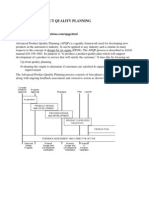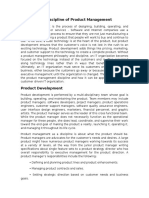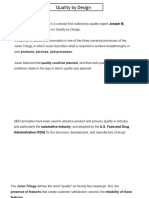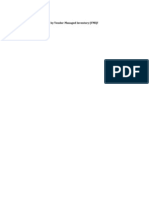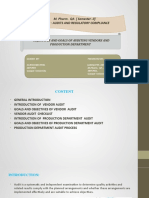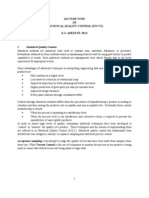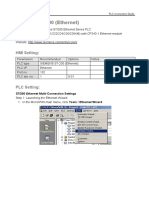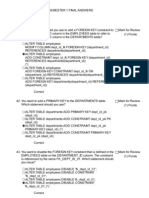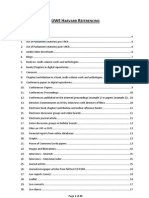Product Quality Assurance Process
Product Quality Assurance Process
Uploaded by
BAshir AhmadCopyright:
Available Formats
Product Quality Assurance Process
Product Quality Assurance Process
Uploaded by
BAshir AhmadCopyright
Available Formats
Share this document
Did you find this document useful?
Is this content inappropriate?
Copyright:
Available Formats
Product Quality Assurance Process
Product Quality Assurance Process
Uploaded by
BAshir AhmadCopyright:
Available Formats
Page 1 of 2
PRODUCT QUALITY ASSURANCE PROCESS
The product quality assurance process is a series of steps taken at the different stages of the product life cycle i.e. from the product concept to the launch of the product to its obsolescence. 1. Define the Objectives The first step while undertaking QA of any project is to define its requirements. For e.g. if the quality planning process has to be evolved for launching a new product or service in the market, then the first step in quality planning should be to understand and document the need of this project and its ultimate goal. At this stage, it is necessary to document the quality goals. These goals should be set according to the quality standards, customer requirements, with reference to the organizations own benchmark performance, competitors performance, according to the law and so on. 2. Understanding Customer Needs The next step in product QA process involves knowing and understanding the needs of the customers. All these needs should be fully explained and documented so that it can be accessed by all the involved personnel whenever required. There are two kinds of customers, i.e. internal and external customers. For example, the manufacturing department is an internal customer of the design department as the designs for manufacturing are supplied by them. Similarly, there are many other internal customers in an organization. So, it is necessary to understand the needs of both internal and external customers. 3. Designing the Product The product should be designed keeping in view the quality goals and needs of the customers defined in step 1 and step 2 respectively. The cost benefit analysis also has to be done in order to ensure that the product will be manufactured at low cost with high quality in order to be successful in the market. 4. Product Pilot Testing Once the product design is ready, the next step of QA process is product testing. The pilot batch of the product is manufactured. The product is tested for various characteristic in accordance with the standards, customer requirements, and regulatory requirements. This is to ensure that the product meets the set goals. Once everything is found satisfactory, the product is approved. 5. Process Development Once the product design has been approved, the entire lists of tasks and activities that will be required for manufacturing the product are listed. The workflow plan is developed. The teams are formed and given specific responsibilities. The timelines for each and every task are specified. Process capability is also measured during this stage of QA process to ensure that the processes are capable of meeting design requirements.
Page 2 of 2
6. Start Manufacturing Once the processes are developed, the required process controls are put in place. Tools like process failure mode and effects analysis are used to identify the likely modes of failures of the process and the effect of those failures on the product performance. Actions are initiated for high-risk items. Audits are planned to periodically measure the performance and give feedback to the manufacturing and design department. 7. Life Cycle Management During the life of the product, the quality will be periodically monitored through inspections and audits. These inputs will result in improvements of the processes or the product design. Customer complaints, if any, will also act as inputs for product and process corrections and improvements. Hence, the product quality assurance process plays an important role during the entire life of the product to ensure that the customer gets a quality product
REQUIREMENTS FOR LAUNCHING A NEW PRODUCT
UNDERSTANDING CUSTOMER NEEDS
DESIGNING THE PRODUCT
PRODUCT PILOT TESTING
PROCESS DEVELOPMENT
START MANUFACTURING
LIFE CYCLE MANAGEMENT
You might also like
- Sop 4Document2 pagesSop 4Leon Hong88% (8)
- QA - QC Basic Knowledge For Civil EngineersDocument58 pagesQA - QC Basic Knowledge For Civil EngineersMahar FarooqNo ratings yet
- Case Study On SDLCDocument9 pagesCase Study On SDLCShubham SharmaNo ratings yet
- Quality PlanningDocument13 pagesQuality PlanningShivam ChoudahaNo ratings yet
- 004 Okkasaari 01 12Document126 pages004 Okkasaari 01 12rbhairavi198470% (61)
- Project Report On QADocument14 pagesProject Report On QARajesh PatankarNo ratings yet
- Quality: Prince 2 Approach To QualityDocument3 pagesQuality: Prince 2 Approach To Qualityquree25No ratings yet
- What Is A Advanced Product Quality Planning (APQP) ?Document9 pagesWhat Is A Advanced Product Quality Planning (APQP) ?Cuenta PokemonNo ratings yet
- SQA CompleteDocument6 pagesSQA CompleteChandraprakash YadavNo ratings yet
- SQA Chapter 2Document3 pagesSQA Chapter 2Usman AsimNo ratings yet
- Product Audit Procedure Example, Plan, Report and ChecklistDocument17 pagesProduct Audit Procedure Example, Plan, Report and Checklistdr.anasasa275No ratings yet
- Subject: Quality Planning and Analysis: (Assignment No.1)Document9 pagesSubject: Quality Planning and Analysis: (Assignment No.1)Sarfraz NawazNo ratings yet
- Advanced Product Quality PlanningDocument2 pagesAdvanced Product Quality PlanningSanjay BaidNo ratings yet
- Chapter 1 QualityDocument6 pagesChapter 1 QualityQuality Dept AsiaNo ratings yet
- TQM Assignment 3Document8 pagesTQM Assignment 3ehte19797177No ratings yet
- Cagsawa RuinsDocument47 pagesCagsawa RuinsmaricelfragaazcarragaNo ratings yet
- 7 Product Realization RequirementsDocument10 pages7 Product Realization RequirementsArman Ul Nasar0% (1)
- APQPDocument3 pagesAPQPSherazi MujtabaNo ratings yet
- Unit 1: Fitness For Use Grade Degree of Preference Degree of Excellence Conformity To RequirementsDocument12 pagesUnit 1: Fitness For Use Grade Degree of Preference Degree of Excellence Conformity To RequirementsNivethithaa DhanrajNo ratings yet
- Hundred IslandsDocument47 pagesHundred IslandsmaricelfragaazcarragaNo ratings yet
- TQM PDFDocument51 pagesTQM PDFCarlo Gojo Cruz HalasanNo ratings yet
- Joseph Juran: Happen by Accident" Gave Rise To The Quality TrilogyDocument7 pagesJoseph Juran: Happen by Accident" Gave Rise To The Quality TrilogyMadhuri HusrajNo ratings yet
- Joseph Juran: Happen by Accident" Gave Rise To The Quality TrilogyDocument7 pagesJoseph Juran: Happen by Accident" Gave Rise To The Quality Trilogy07081988No ratings yet
- FDA Lifecycle Approach To Process Validation-What, Why & How?Document25 pagesFDA Lifecycle Approach To Process Validation-What, Why & How?Neeraj Kumar RaiNo ratings yet
- Rekayasa Kualitas Rekayasa Kualitas Pertemuan 4: Teknik IndustriDocument15 pagesRekayasa Kualitas Rekayasa Kualitas Pertemuan 4: Teknik IndustriDeni Deri SetianaNo ratings yet
- Apparel Quality Management: National Institute of Fashion TechnologyDocument13 pagesApparel Quality Management: National Institute of Fashion TechnologyBhaswati PandaNo ratings yet
- Mini Project Report On Online ShoppingDocument14 pagesMini Project Report On Online ShoppingAkbarNo ratings yet
- Phases of QualityDocument4 pagesPhases of Qualityamer_wahNo ratings yet
- The Discipline of Product ManagementDocument10 pagesThe Discipline of Product ManagementGodofredo O̲̲̅̅f̲̲̅̅i̲̲̅̅c̲̲̅̅i̲̲̅̅a̲̲̅̅l̲̲̅̅'̲̲̅̅F̲̲̅̅b̲̲̅̅No ratings yet
- Quality by DesignDocument15 pagesQuality by Designvivekanand879355443612No ratings yet
- Unit 5 Quality ManagementDocument7 pagesUnit 5 Quality ManagementKezzy KayNo ratings yet
- Product ManagementDocument9 pagesProduct ManagementKu RatheeshNo ratings yet
- Software Quality Management 05Document28 pagesSoftware Quality Management 05tesfanesh 65tgNo ratings yet
- Role of QC & QA in OperationsDocument6 pagesRole of QC & QA in OperationsmaheshNo ratings yet
- PRINCE2® Theme: QualityDocument3 pagesPRINCE2® Theme: QualitySocrates KontosNo ratings yet
- Q.1 What Do You Understand by Vendor-Managed Inventory (VMI) ?Document21 pagesQ.1 What Do You Understand by Vendor-Managed Inventory (VMI) ?Amar GiriNo ratings yet
- Ingeniero de ProductoDocument27 pagesIngeniero de ProductoJuan Diego Arroyave SernaNo ratings yet
- Objectives and Goals of Auditing Vendors and Production Department 2.-1Document15 pagesObjectives and Goals of Auditing Vendors and Production Department 2.-1Devang Gondaliya100% (3)
- Process Design and Analysis: Process Development For Process Design Can Be Summarized Through Following StepsDocument2 pagesProcess Design and Analysis: Process Development For Process Design Can Be Summarized Through Following Stepsanushka goelNo ratings yet
- Unit 4 FinalDocument30 pagesUnit 4 Finalsiddharthamudgal99No ratings yet
- Product DevelopmentDocument4 pagesProduct Developmentndwalanethobeka3No ratings yet
- SQA Paper Solution Nov19Document16 pagesSQA Paper Solution Nov19satyamshingade2No ratings yet
- Define The Term Quality ? Elaborate Different Views On Quality ? Explain Its Core Component ?Document15 pagesDefine The Term Quality ? Elaborate Different Views On Quality ? Explain Its Core Component ?ANUP THAKURNo ratings yet
- Lecture Note On Statistical Quality ControlDocument25 pagesLecture Note On Statistical Quality ControlKayode Samuel83% (6)
- Study of ISO 9001:2000 Quality Management System: A Project Report OnDocument60 pagesStudy of ISO 9001:2000 Quality Management System: A Project Report Onketanjc100% (1)
- Assignment DCC40132Document6 pagesAssignment DCC40132Ammar ZikryNo ratings yet
- Chapter 5 Process Selection and Design AnalysisDocument8 pagesChapter 5 Process Selection and Design AnalysisBless YacatNo ratings yet
- Chapter Three Design of The Operation SystemDocument80 pagesChapter Three Design of The Operation Systemhabtamu tadesseNo ratings yet
- Standard Operating ProcedureDocument6 pagesStandard Operating ProcedureBalasubramani GNo ratings yet
- LGB 20503 Section 2 Quality PlanningDocument20 pagesLGB 20503 Section 2 Quality PlanningMuhd AsyrafNo ratings yet
- Assignment 2 QADocument7 pagesAssignment 2 QAsarfraz.42aug24webgptNo ratings yet
- Unit - IDocument45 pagesUnit - INihal KocheNo ratings yet
- 7.which Major Task Do You Think Is More Important in Production Management?Document2 pages7.which Major Task Do You Think Is More Important in Production Management?Ihk HimelNo ratings yet
- TVE-FCM10 Q1M4Weeks78 OKDocument18 pagesTVE-FCM10 Q1M4Weeks78 OKjooshmarkhenNo ratings yet
- Unit-Iii: Quality Control and Materials ManagementDocument39 pagesUnit-Iii: Quality Control and Materials ManagementLAKKANABOINA LAKSHMANARAONo ratings yet
- The Stages of Product DevelopmentDocument10 pagesThe Stages of Product Developmentsrivastavakarishma18No ratings yet
- Unit 1: Quality Definitions by "QUALITY GURUS"Document9 pagesUnit 1: Quality Definitions by "QUALITY GURUS"Suraz DuveshNo ratings yet
- Bbs Datasheet Rev CDocument2 pagesBbs Datasheet Rev Capi-170472102No ratings yet
- Data WarehouseDocument46 pagesData WarehouseandranormanNo ratings yet
- Companies Interview Questions: Bhawan Cyber TechDocument17 pagesCompanies Interview Questions: Bhawan Cyber TechharifavouriteenglishNo ratings yet
- bfg135 PDFDocument12 pagesbfg135 PDFIvan GvozdenovicNo ratings yet
- TTControl HY EVision2 7.0 DatasheetDocument2 pagesTTControl HY EVision2 7.0 DatasheetSergio Martinez MartinNo ratings yet
- Product Specifications For The HP Scanjet 4500c and 5500c SeriesDocument2 pagesProduct Specifications For The HP Scanjet 4500c and 5500c SeriesTaur1968No ratings yet
- Siemens S7 200 EthernetDocument7 pagesSiemens S7 200 EthernetAlberto HernandezNo ratings yet
- ICT Skills Worksheet IIprintoutsDocument9 pagesICT Skills Worksheet IIprintoutspvishnuvardhan2022No ratings yet
- Scholar Cu Edu Eg PDFDocument24 pagesScholar Cu Edu Eg PDFFrancisco LeónNo ratings yet
- User Manual: Wlm2 Wlta WLTD WLTP Wlct2Document30 pagesUser Manual: Wlm2 Wlta WLTD WLTP Wlct2jamppajoo2No ratings yet
- Computer: 5 Generations of ComputersDocument6 pagesComputer: 5 Generations of ComputersAayush AroraNo ratings yet
- Artificial Intelligence Engineer: Master's CourseDocument21 pagesArtificial Intelligence Engineer: Master's CourseMeghasundar MohapatraNo ratings yet
- Project Report On Marketing Strategies of VodafoneDocument73 pagesProject Report On Marketing Strategies of VodafonePankaj GandhiNo ratings yet
- Network Manager / Distribution: Industrial For Energy System OperationDocument8 pagesNetwork Manager / Distribution: Industrial For Energy System OperationChihiya Fitria NurhayatiNo ratings yet
- 19 Cost Engineer Interview Questions (With Example Answers)Document19 pages19 Cost Engineer Interview Questions (With Example Answers)Rahul JangirNo ratings yet
- DSP GroupDocument11 pagesDSP Groupwingrider4No ratings yet
- Virtualization With KVM and LibvirtDocument7 pagesVirtualization With KVM and LibvirtsofiawalgodecarranchoNo ratings yet
- CB - Linked ListDocument44 pagesCB - Linked ListAryan RathoreNo ratings yet
- TM Synchronization and Channel Coding: Recommendation For Space Data System StandardsDocument92 pagesTM Synchronization and Channel Coding: Recommendation For Space Data System StandardsmarioNo ratings yet
- Oracle PLSQL Semester 1 Final AnswersDocument3 pagesOracle PLSQL Semester 1 Final AnswersJake DeweyNo ratings yet
- Bassbuds B21 Product Manual 09.09.22Document2 pagesBassbuds B21 Product Manual 09.09.22Eagle Eye GamingNo ratings yet
- CS (ECE) 301-DS-SuggestionDocument2 pagesCS (ECE) 301-DS-SuggestionSayani ChandraNo ratings yet
- Sushi Sensor Rd-Te-R06101-003 PDFDocument4 pagesSushi Sensor Rd-Te-R06101-003 PDFRiki HermansyahNo ratings yet
- Success Failure or No Significant DifferenceDocument9 pagesSuccess Failure or No Significant DifferenceRussel J. CorpuzNo ratings yet
- Fiitjee Exam Admit CardDocument1 pageFiitjee Exam Admit Cardtamonash123deyNo ratings yet
- Connecting To ASM Through ClientDocument5 pagesConnecting To ASM Through Clientangeldn06No ratings yet
- 1995 Book PDFDocument381 pages1995 Book PDFKrishnav KishorNo ratings yet
- Date-Sheet of UG PG (SemesterAnnual System) Nov-Dec-2012Document258 pagesDate-Sheet of UG PG (SemesterAnnual System) Nov-Dec-2012ajay153No ratings yet
- Harvard-UWE Referencing GuideDocument30 pagesHarvard-UWE Referencing GuiderufftuffcookieNo ratings yet

















